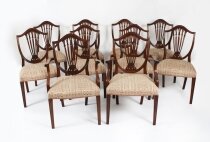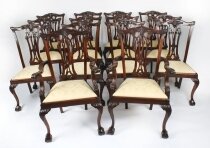Gillow & Co.
was originally founded in Lancaster in 1730. Gillow’s of Lancaster was a household name in Victorian Britain, and the firm exported furniture throughout the Empire. Key to the company’s success was the dynamic father and son team at its core.
The London branch was opened in 1775. Among Gillow’s most successful pieces during this period were those made in the Neoclassical style from original drawings by Robert Adam. In the period 1813-1820 the Gillow family gradually withdrew from personal involvement with the business.
In 1897 Gillow & Co. merged with a Liverpool firm and they henceforth traded as Waring & Gillow.
Antique Hall Chairs were first introduced in the late Georgian period, usually made in pairs and in Mahogany or Oak woods. These dainty antique chairs were often built by skilled cabinet makers in fine timbers and ornately carved with scrolls, shell motifs or even inlays. Hall chairs were situated in the entrance or hall and used for guests to wait until they were invited into dining rooms and they were also used for servants to wait during servings.
Mahogany
is probably one of the largest ‘families’ of hardwood, having many different varieties within its own species.
Mahogany has been used for centuries in ship building, house building, furniture making etc and is the core structure of just about every 19th century vanity box, dressing case or jewellery box. It became more of a Victorian trend to dress mahogany with these decorative veneers, such as kingwood, burr walnut and coromandel, so tha,t the actual mahogany was almost hidden from view.
Mahogany itself is a rich reddish brown wood that can range from being plain in appearance to something that is so vibrant, figured and almost three dimensional in effect.
Although Mahogany was most often used in its solid form, it also provided some beautifully figured varieties of veneer like ‘Flame’ Mahogany and ‘Fiddleback’ Mahogany (named after its preferred use in the manufacture of fine musical instruments).
Cuban Mahogany was so sought after, that by the late 1850′s, this particular variety became all but extinct.















